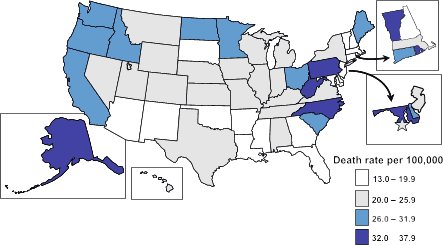 |
|
 |
 |
 |
Fact Sheets and At–a–Glance Reports
Atrial Fibrillation Fact Sheet
This document is also available in
Portable
Document Format (PDF - 74K).
Learn more about
PDFs.
Age-adjusted death rates for atrial fibrillation as a
contributing cause—United States, 1999

Age adjusted to the 2000 U.S. population
Source: 1999 mulitple-cause mortality data from the National Vital
Statistics, CDC. MMWR 2003;52:128–131.
[A text
version of this graphic is also available.]
Facts on
Atrial Fibrillation
- Atrial fibrillation is the most common sustained heart rhythm
disorder and increases the risk for heart disease and stroke, both
leading causes of death in the United States. An estimated 2.2 million
adults in the United States have been diagnosed with atrial
fibrillation.1
- Atrial fibrillation is the quivering of the top right chamber of the
heart. It is characterized by a rapid and irregular beat that can
cause serious complications, even death. If the heart rate is rapid
and irregular, a healthcare provider should be seen quickly. Ideal
adult pulse is steady with regular rates of 60–80 beats per minute.
- Deaths associated with atrial fibrillation mortality have increased
over the past two decades. Overall, the age-standardized death rate
(per 100, 000 US population) increased from 27.6 in 1980 to 69.8 in
1998.2
- The prevalence of atrial fibrillation increases markedly with age in
older adults, from less than 1 percent for those younger than age 60
to roughly 1 in every 10 persons aged 80 years or older.1,3
- Studies have shown that men have a higher prevalence of atrial
fibrillation than women, and whites have a higher prevalence than
African Americans.1
- Other factors associated with the development of atrial fibrillation
include hypertension, congestive heart failure, previous myocardial
infarction and diabetes.4
- Atrial fibrillation (AF) accounts for one fourth of all strokes in the
elderly. The American Heart Association reports that in the U.S., AF
is estimated to be responsible for over 70,000 strokes each year.
- Anti-arrhythmia medications can help regularize the heart rhythm
and help prevent the arrhythmia from happening again. In addition,
medications that reduce the risk of blood clot formation (aspirin and warfarin are the two most common) can help reduce stroke risk in
persons with atrial fibrillation.5
- Signs and symptoms that suggest the presence of atrial fibrillation
include a sensation of missed or extra heartbeats, an unexplained
rapid heartbeat, or palpitation.
- Persons can identify an irregular heartbeat by monitoring their
wrist pulse for 1 minute. The irregularity of these beats is detected
and the next beat cannot be predicted. Persons who identify the signs
of cardiac arrhythmia should seek medical care to determine the
presence of AF or other heart disorders.
- Consult your health care provider if you believe you have an
irregular heart rhythm or palpitations.
CDC's Public Health Efforts
CDC currently funds health departments in 32 states and the District of
Columbia to develop effective strategies to reduce the burden of
cardiovascular diseases and related risk factors with an overarching
emphasis on heart healthy policies and physical and social environmental
changes. Through these state programs, CDC aims to reduce disparities in
treatment, risk factors, and disease; delay the onset of disease; postpone
death from cardiovascular disease; and reduce disabling conditions. For
more information on CDC's State Heart Disease and Stroke Prevention
Program, please visit our Web site at
http://www.cdc.gov/dhdsp/state_program/index.htm.
For More Information
More information on atrial fibrillation and other heart rhythm problems
can be obtained from the following organizations:
National Heart, Lung, and Blood Institute, National Institutes of
Health
http://www.nhlbi.nih.gov
American Heart Association
http://www.americanheart.org/*
American Stroke Association
http://www.strokeassociation.org*
National Stroke Association
http://www.stroke.org*
The Research Center for Stroke and Heart Disease
http://www.strokeheart.org/*
References
- Go AS, Hylek EM, Phillips KA, Chang Y, Henault LE, Selby JV, Singer
DE. Prevalence of diagnosed atrial fibrillation in adults. National
implications for rhythm management and stroke prevention: the
Anticoagulation and Risk Factors In Atrial Fibrillation (ATRIA) Study.
JAMA 2002;285:2370–2375.
- Wattigney WA, Mensah GA, Croft JB. Increased atrial fibrillation
mortality: United States, 1980–1998. Am J Epidemiol.
2002;155:819–826.
- Feinberg WM, Blackshear JL, Laupacis A, Kronmal R, Hart RG.
Prevalence, age distribution, and gender of patients with atrial
fibrillation. Analysis and implications. Arch Intern Med.
1995;155:469–473.
- Benjamin EJ, Levy D, Vaziri SM, D'Agostino RB, Belanger AJ, Wolf PA.
Independent risk factors for atrial fibrillation in a population–based
cohort. The Framingham Heart Study. JAMA. 1994;271:840–84.
- Ezekowitz MD, Bridgers SL, James KE, et al. Warfarin in the
prevention of stroke associated with nonrheumatic atrial fibrillation:
Veterans Affairs Stroke Prevention in Nonrheumatic Atrial Fibrillation
Investigators. N Engl J Med. 1992;327:1406–1412.
*Links to non–Federal organizations are provided solely as a service to our users. Links do not constitute an endorsement of any organization by CDC or the Federal Government, and none should be inferred. The CDC is not responsible for the content of the individual organization Web pages found at this link.
Return to Top of Page
Page last reviewed: April 21, 2008
Page last modified: April 21, 2008
Content source: Division for Heart Disease and Stroke
Prevention,
National Center for Chronic Disease Prevention and
Health Promotion |
 |